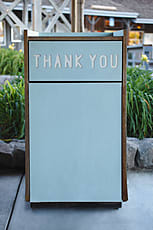This is true. The industry is very young and has not yet faced the other side of sales: what to do with discarded media at the end of its useful life. My guess would be some sort of mass-scale recycling but that has yet to be worked out. However, to be fair, this is true for all batteries, not just lithium batteries. All batteries should be disposed of properly, and properly is not throwing batteries into the kitchen trash when they are EOL.
Well, unlike the blight of soda pop cans/bottles that some areas have resolved through significant (another subjective term of varying degree of encouragement to the wallet of the consumer) deposits, recycling of batteries is often punitive.
Years ago in the early days of trying to save Mother Earth from our ecological sins, signs were posted in several convenient...yet unlikely...locations. "We recycle batteries!", they proudly said in the window of our local chain-type grocery store. So we tried. All those AA's and AAA's, C's, D's, 9volt's...accumulated in a nice sackful.
Proudly took the weighty sack to the store one day. Handed them to a customer service clerk. She smilingly said, 'Why thank you! That'll be $$, please!'

I'm supposed to pay for the funeral expenses of these??
Yepper. She said that, unlike paper, plastics, bottles/cans, ...all those other things that archeologists millenia from now would delight in finding while mining Mt. Trashmore..., your minimal atonement for the sin of using disposable electrolytics is $$!
Well, I joined the vast well-intentioned hoi polloi in relieving her of the sack full of batteries, walked toward the door, ...and found the perfect receptacle for it. Free of charge. Even with a big "THANK YOU" emblazoned on the side...

But, hey, years later...a couple months ago, in fact...I went to a BATTERY STORE (That's all they sell!) to rejuvenate a special and very handy product that required a unique battery that only existed in this very useful product...that has since been re-designed/replaced with a 'better' version...with another unique battery...that will someday.........oh, never mind. While there, I noticed they had the same happy sign as in that grocery store window years earlier! I asked about their policy for returning a sackful of cells. Same response. Open, extended, up-turned palm...a very popular American greeting.
The nice thing about that trashcan? It politely appreciated your business...without muttering "Idiot!" under its breath as you...and your wounded wallet...departed. You're welcome!!
Crazy. 
Meanwhile, back at my happy place in the workshop and basement...










